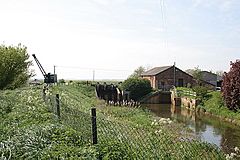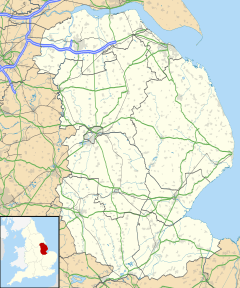Witham First District IDB facts for kids
Quick facts for kids Witham First District IDB |
|
|---|---|
 Timberland pumping station at Thorpe Tilney Dales, which was superseded by electric pumps, and is open to the public. |
|
| OS grid reference | TF187560 |
| Shire county | |
| Region | |
| Country | England |
| Sovereign state | United Kingdom |
| EU Parliament | East Midlands |
The Witham First District IDB is a special group in England that helps manage water. IDB stands for "Internal Drainage Board." Their main job is to keep land from flooding by controlling water levels.
This group was officially started in 1934. However, its history goes back much further to 1762. That's when the Witham General Drainage Commissioners were first set up by a special law.
Today, the Witham First District IDB manages water in an area west of the River Witham. This area stretches between Lincoln and Dogdyke. It also includes the valley of the River Slea up to Sleaford.
The land they look after is split into different sections. This is because rivers with raised banks cross the area. These rivers carry water from the Car Dyke (a drain on the western side) to the River Witham on the eastern side.
Many of the local areas were organized in the late 1700s. People started using steam-powered pumps to drain water in the 1830s. Later, these steam engines were replaced by oil and diesel engines. Now, most of the pumps use electricity. The Witham First District IDB looks after thirteen pumping stations and about 165 miles (265 km) of drainage channels.
How the Water Board Works
The River Witham flows through flat land in Lincolnshire. This area can easily flood. To stop this, a special law was passed in 1762. This law created the Witham General Drainage Commissioners. They divided the area into six districts, each responsible for managing water. These were called the Witham First, Second, Third, Fourth, Fifth, and Sixth Districts.
The First District covered a large area of about 24,916 acres (10,083 hectares). It was bordered by the River Witham to the north and east. To the south and west, it was bordered by the Car Dyke, an old waterway. The Fifth District was much smaller, about 5,176 acres (2,095 hectares). It was located between Billinghay Skirth and Kyme Eau, which is the lower part of the River Slea. In 1953, the Fifth District joined the First District.
At first, there were 23 people in charge of the First District. Each of the eighteen local areas (called parishes) in the First District chose one person. Five more people came from parishes in the Fifth District. Each district also chose some of the 31 General Drainage Commissioners. Seven came from the First District and two from the Fifth District. The rest came from the other four similar groups.
A new law, the Land Drainage Act 1930, allowed for the creation of internal drainage boards. The Witham and Steepings Catchment Board, which managed the rivers then, suggested creating the Witham First District IDB. This new board officially started on January 8, 1934.
In 1951, the board was changed to include six more members. This happened when the Witham Fifth District IBD was closed down and joined with the First District. The First District's area of responsibility grew even more in 1968. Parts of fourteen parishes and the town of Sleaford came under its control. The board was changed again on July 7, 1993. This time, it included representatives from local councils, as required by a new law from 1991.
The Landscape and Rivers
The area managed by the IDB is divided into sections by several rivers. These rivers act like "highland carriers." This means their water level is usually higher than the land around them. However, flood banks prevent the water from overflowing.
The main river is the Witham, which flows from north to south through the area. There is also the Car Dyke, which runs next to the Witham but further west. The Car Dyke collects water that would otherwise flow into the low-lying land.
Between the Witham and the Car Dyke, there are seven other channels that run from west to east. Starting in the north, near Lincoln, and moving south towards Boston, these are:
- Sandhill Beck
- Branston Delph
- Nocton Delph
- Metheringham Delph
- Timberland Delph
- Billinghay Skirth
- Kyme Eau (another name for the lower part of the River Slea)
The water level in most of these channels is usually the same as the Witham. But they have special doors where they meet the Witham. These doors close automatically if the water level in the Witham gets too high. All these channels are considered "main rivers" and are managed by the Environment Agency. The total length of rivers in or next to the district is about 94 miles (151 km). These rivers are held back by about 125 miles (201 km) of banks.
The area managed by the First District IDB is east of the Lincoln Edge. This is a limestone hillside that is a big feature in Lincolnshire. Several small streams get their water from springs on this hillside. The Car Dyke collects water from these streams. It connects to the start of the "Delphs," letting water flow into them by gravity. At Billinghay Skirth, a small gate connects the two waterways.
The district covers an area of about 60.82 square miles (157.5 km2). Almost all of this land, about 59.79 square miles (154.8 km2), is used for farming. The area that drains into the district is even larger, including an extra 2.88 square miles (7.46 km2). Inside the district, about 11.8 acres (4.8 hectares) are a special protected area for nature called a Site of Special Scientific Interest. Also, 74 acres (30 hectares) of Metheringham Delph are a nature reserve.
Pumping Stations
The Witham First District IDB uses pumping stations to move water and prevent flooding. These stations have powerful pumps that can move huge amounts of water every day. The table below shows where these pumping stations are located. It also tells you how many pumps they had in 2008 and how much water they could pump each day. One megalitre per day (Mld) is a very large amount of water!
| Point | Coordinates (Links to map resources) |
OS Grid Ref | Notes |
|---|---|---|---|
| Sandhill Beck PS | 53°13′45″N 0°26′22″W / 53.2293°N 0.4395°W | TF042713 | 1 pump (73 Mld) |
| Heighington PS | 53°13′48″N 0°23′48″W / 53.2299°N 0.3967°W | TF071715 | 2 pumps (96 Mld) |
| Branston PS | 53°13′04″N 0°21′17″W / 53.2178°N 0.3546°W | TF099702 | 2 pumps (102 Mld) |
| Nocton PS | 53°11′33″N 0°19′35″W / 53.1926°N 0.3265°W | TF119674 | 2 pumps (202 Mld) |
| Metheringham PS | 53°10′50″N 0°17′41″W / 53.1805°N 0.2948°W | TF140661 | 2 pumps (181 Mld) |
| Blankney PS | 53°09′26″N 0°15′30″W / 53.1571°N 0.2583°W | TF165636 | 2 pumps (229 Mld) |
| Timberland PS | 53°06′33″N 0°13′28″W / 53.1091°N 0.2245°W | TF189583 | 3 pumps (253 Mld) |
| Billinghay PS | 53°05′19″N 0°14′30″W / 53.0887°N 0.2418°W | TF178560 | 1 pump (80 Mld) |
| Chapel Hill PS | 53°04′13″N 0°12′35″W / 53.0702°N 0.2097°W | TF200540 | 2 pumps (216 Mld) |
| North Kyme PS | 53°04′11″N 0°15′01″W / 53.0696°N 0.2502°W | TF173539 | 2 pumps (87 Mld) |
| Ringmoor PS | 53°04′17″N 0°17′00″W / 53.0713°N 0.2833°W | TF151540 | 1 pump (5 Mld) |
| Farroway PS | 53°03′54″N 0°17′26″W / 53.0651°N 0.2905°W | TF146533 | 3 pumps (226 Mld) |
| Digby PS | 53°04′14″N 0°17′46″W / 53.0706°N 0.2962°W | TF142539 | 2 pumps (87 Mld) |


